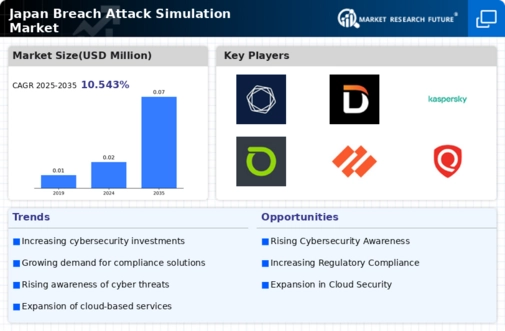Rising Cybersecurity Threats
The breach attack-simulation market in Japan is experiencing growth due to the increasing frequency and sophistication of cyber threats. Organizations are recognizing the need for proactive measures to safeguard sensitive data. In 2025, it is estimated that cybercrime could cost the Japanese economy over $1 trillion, prompting businesses to invest in breach attack-simulation solutions. This market is expected to expand as companies seek to identify vulnerabilities before they can be exploited. The urgency to protect against data breaches is driving demand for simulation tools that can replicate real-world attack scenarios, thereby enhancing overall security posture. As a result, the breach attack-simulation market is likely to see a surge in adoption across various sectors, including finance, healthcare, and manufacturing.
Regulatory Compliance Requirements
Japan's regulatory landscape is becoming increasingly stringent, with laws such as the Act on the Protection of Personal Information (APPI) mandating organizations to implement robust cybersecurity measures. Compliance with these regulations is crucial for businesses to avoid hefty fines and reputational damage. The breach attack-simulation market is benefiting from this trend, as organizations seek to ensure they meet compliance standards. In 2025, it is projected that the market for compliance-related cybersecurity solutions will grow by approximately 15%. Companies are turning to breach attack-simulation tools to conduct regular assessments and demonstrate adherence to regulatory requirements. This proactive approach not only mitigates risks but also fosters trust among customers and stakeholders, further driving the market's expansion.
Increased Investment in Cybersecurity
The breach attack-simulation market is witnessing a surge in investment as organizations in Japan allocate more resources to cybersecurity. In 2025, it is anticipated that spending on cybersecurity solutions will reach $10 billion, reflecting a growing recognition of the importance of safeguarding digital assets. This influx of capital is enabling the development of advanced breach attack-simulation tools that offer more sophisticated features and capabilities. As businesses strive to stay ahead of emerging threats, they are increasingly adopting simulation technologies to test their defenses. The competitive landscape is evolving, with new entrants and established players vying for market share, thereby enhancing innovation within the breach attack-simulation market.
Growing Awareness of Cybersecurity Risks
There is a notable increase in awareness regarding cybersecurity risks among organizations in Japan. This heightened consciousness is driving the demand for breach attack-simulation solutions, as companies seek to understand their vulnerabilities and improve their security measures. Educational initiatives and industry collaborations are playing a pivotal role in disseminating information about potential threats. In 2025, it is estimated that around 70% of businesses will have implemented some form of breach attack-simulation to assess their security posture. This trend indicates a shift towards a more proactive approach to cybersecurity, where organizations are not only reacting to incidents but also preparing for potential breaches. The breach attack-simulation market is thus positioned for growth as awareness continues to rise.
Technological Advancements in Cybersecurity
The breach attack-simulation market is being propelled by rapid technological advancements in cybersecurity. Innovations such as artificial intelligence (AI) and machine learning (ML) are enhancing the capabilities of simulation tools, allowing for more realistic and effective testing of security measures. In 2025, it is projected that AI-driven solutions will account for over 30% of the breach attack-simulation market. These technologies enable organizations to simulate complex attack scenarios and analyze their responses in real-time. As businesses in Japan strive to adopt cutting-edge solutions, the demand for advanced breach attack-simulation tools is likely to increase. This trend not only improves security outcomes but also fosters a culture of continuous improvement within organizations.


























Leave a Comment